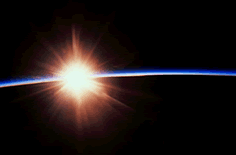| |
| |
In the stratosphere, the region of the Earth's atmosphere
from 6 to 30 miles (10 to 50 kilometers) above the surface, the
chemical compound ozone plays a vital role in absorbing harmful
ultraviolet radiation from the sun. During the past 20 years, concentrations
of this important compound have been threatened by human-made gases
released into the atmosphere, including those known as CFCs. These
chemical compounds as well as meteorological conditions in the stratosphere
affect the concentration of stratospheric ozone. |
|

Photo courtesy of NASA
|
|
| |
NOAA uses satellite, airborne and ground-based systems to continuously
monitor stratospheric ozone as well as the chemical compounds and
atmospheric conditions that affect its concentration. NOAA's Earth System Research Laboratory - Chemical Sciences Division (formerly the Aeronomy
Laboratory), Earth System Research Laboratory - Global Monitoring Division, Climate
Prediction Center and the National Climatic Data Center are actively
involved in monitoring and research, which enhances the scientific
understanding of ozone and the processes affecting its concentration
in the stratosphere. This site provides information on these NOAA
organizations, links to current and historical stratospheric ozone
and climate data as well as information on the science of ozone.
A list of NOAA representatives, recent ozone-related press releases
and frequently asked questions are also provided via the pulldown
menu above.
|
|
|
|
|
These pages have been
created through a collaborative effort involving the following
NOAA organizations:
|
|
|
|

